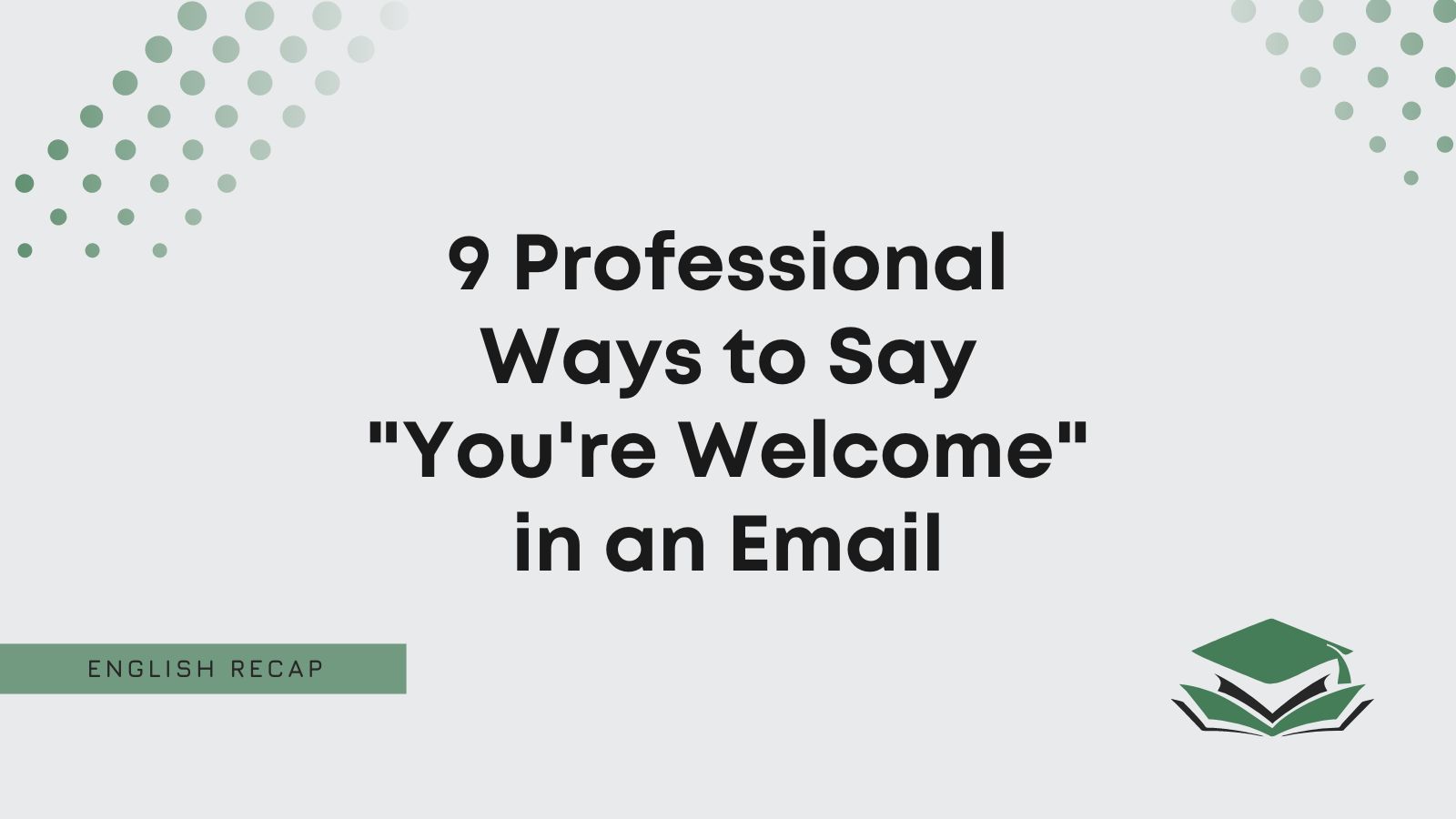Do you want to know better ways to say “you’re welcome” in an email?
Perhaps you’re concerned the phrase itself is a bit dismissive or unprofessional.
Luckily, that’s exactly what this article is here to help you understand.
We’ll teach you how to say “you’re welcome” professionally in an email when you need to use a more formal tone.
Is It Professional to Say “You’re Welcome”?
It is professional to say “you’re welcome” in an email. It’s formal and shows you’re receiving someone’s thank-you message with positivity.
It’s a good email reply when someone thanks you. So, you really can’t go wrong with using it in most formal cases.
Also, it’s worth reviewing this email example to learn a bit more:
Dear Miss Jefferson,
You’re welcome. I hope we can work together on this again soon.
Please let me know if you need anything else from me in the meantime.
Yours,
Tony Bracken
Pros
- It’s a great way to receive a thank-you email positively.
- It’s professional and sincere.
Cons
- It can seem a bit impersonal.
- It’s not always the most inspiring or interesting way to reply to a thank-you email.
Well, it’s clear that there’s nothing wrong with using “you’re welcome” in a formal email. However, you should explore other options to see if anything else works for your writing.
So, keep reading to learn how to reply “you’re welcome” professionally. We’ve gathered an incredible list of synonyms to help you see what else is out there.
What to Say Instead of “You’re Welcome”
- My pleasure
- Happy to help
- I’m here to assist
- It was my pleasure to assist you
- Not a problem at all
- I’m glad I could be of assistance
- I’m at your service
- Don’t hesitate to reach out if you have more questions
- It was no trouble at all
1. My Pleasure
You can always start with “my pleasure” as a different way to say “you’re welcome” professionally in an email.
It’s an excellent formal synonym that lets someone know you’re more than happy to assist them.
It also works really well in an email response when someone says thank you. After all, it suggests that helping them was a “pleasure” to you, so you’d happily do it again.
You can use something like this when responding to a customer.
It’s a good way to keep things more genuine and sincere if they’ve reached out to thank you for your help.
Also, you may want to review this example to learn more:
Dear Ms. Wells,
It’s my pleasure, and I hope you know you can reach out when you need me again.
Until then, I hope you enjoy your new product.
Best wishes,
Tony Martins
2. Happy to Help
You can also simplify things by writing “happy to help.” This is another way to say “you’re welcome” in a business email.
It’s effective because it’s formal and sincere.
It’s also a common choice used in customer service roles. After all, it suggests that you’re always happy to assist a customer, no matter what needs they might have.
The more willing you are to help customers, the happier your clientele will be. That’s what makes this phrase so effective when you’re trying to build a positive rapport.
You can review the following sample email to learn a bit more about it:
Dear Mr. Adams,
I’m happy to help, and I’m only an email away.
Please let me know if there’s anything else I can assist you with.
Best wishes,
Doris Danvers
3. I’m Here to Assist
To go back to something more formal, try “I’m here to assist.” This is a professional synonym for “you’re welcome” that shows you’re happy to help someone when they need it.
You can use it in an email response to someone saying “thank you.” It’s an ideal way to show that it’s no trouble at all and you’d be happy to help them again when necessary.
So, it might be worth using this when writing to a client. It’s an effective way to let them know you’re always there for them.
Also, it helps that the phrase is direct and sincere. It’s an excellent chance for you to prove to your clients that their needs come first.
It’s worth reviewing this example if you still need help with it:
Dear Miss Hall,
I’m here to assist you with matters like this, so you don’t need to thank me.
Feel free to contact me again if there’s anything else I can do.
All the best,
Rosanna Cheeks
4. It Was My Pleasure to Assist You
Feel free to use “it was my pleasure to assist you” in a professional email. It’s an excellent way to show that you’re always willing to assist someone after they thank you.
This could work well when helping a client.
As professional synonyms go, this is an excellent way to build trust in you or your company. It gives clients a chance to see that you’re there for them, and they’ll remember that.
Also, it’s smart to review the following example to learn more about it:
Dear Ms. Mathews,
It was my pleasure to assist you with this.
Please let me know if there’s anything else you might need.
Best,
Tom Jones
5. Not a Problem at All
You may also use “not a problem at all” to receive someone’s thanks.
It’s a positive and friendly way to accept a thank-you email. It replaces “you’re welcome” because it shows you had no issues with helping someone and would be happy to do it again.
For the most part, this is formal and direct. Therefore, you may want to use it when replying to your boss.
After all, it establishes that you know what you’re doing when helping them. This could make you seem like a more reliable employee, and they might be more inclined to ask you for help in the future.
Check out the following sample email if you’d like more information:
Dear Mr. Wall,
It’s not a problem at all, and I’m always happy to help.
I look forward to hearing from you after you’ve used my advice.
All the best,
Zoe Clarkson
6. I’m Glad I Could Be of Assistance
It’s also good to write “I’m glad I could be of assistance.”
Generally, this is a direct and friendly way to show you’re happy to help someone.
It works best when responding to customers. After all, it lets them know that you didn’t have any problems when it came to helping them.
Since helping customers is most likely your job role, this phrase works really well. It makes the customers feel valued and give it that more personal touch.
Also, it’s good to review the following email sample to learn more:
Dear Miss Catford,
I’m glad I could be of assistance.
Of course, I’m still available if there’s anything else you need help with.
Yours,
Georgia Dickinson
7. I’m at Your Service
It’s always good to show customers how much you care. Phrases like “I’m at your service” go a long way when demonstrating this feat.
After all, this synonym allows a customer to see that you’re reliable and trustworthy. It suggests that when they email you, you’ll always be there to answer their queries.
We highly recommend including this as a formal yet friendly way to show a customer you can help them.
Therefore, it works pretty well in response to thank-you emails. It is direct and suggests that a customer doesn’t need to thank you, as you’ll always be available to them.
Also, you can check out this email example to learn more about it:
Dear Mr. Tiding,
I’m at your service, and I’d like you to remember that.
You can always count on me to assist you with these issues.
Yours,
Jonathan Wells
8. Don’t Hesitate to Reach Out if You Have More Questions
Next, use “don’t hesitate to reach out if you have more questions.”
This is great in an email response to give clients confidence in your abilities.
Originally, they might have sent you an email asking for help. Once you’ve addressed their initial query and received a thank you from them, a phrase like this will help you to close your conversation.
It suggests that you’ll be happy to hear from them again if they have further questions. It’s open-ended and formal, encouraging most clients to get back in touch later.
You can review this sample email if you still need help with it:
Dear Ms. Cliche,
I’m glad you got what you need out of our email exchange.
Don’t hesitate to reach out if you have more questions.
All the best,
Sophie Miller
9. It Was No Trouble at All
The last phrase we want to go over is “it was no trouble at all.” This works well when replacing “you’re welcome” in a formal email response.
It’s professional and sincere. Also, it shows that you had no issues helping someone, so you’d be happy to do it again.
It might be worth including this when replying to your boss. It shows you’re a reliable employee, and they should trust you in the future with whatever issues they have.
Feel free to review the following email sample to find out more:
Dear Miss Maxine,
It was no trouble at all, and I’m always here to help.
Please let me know if there’s anything else I can do.
All the best,
Joey Ample

